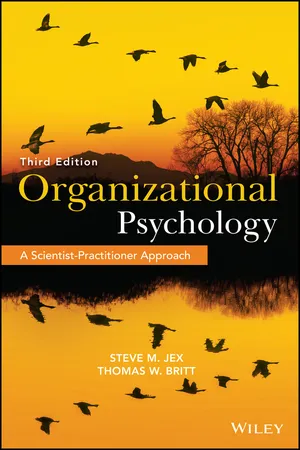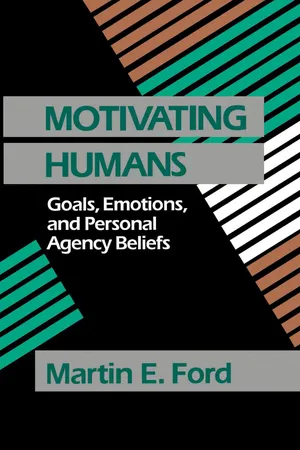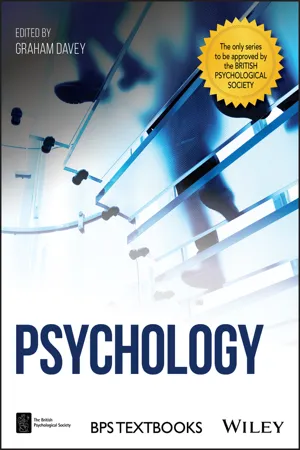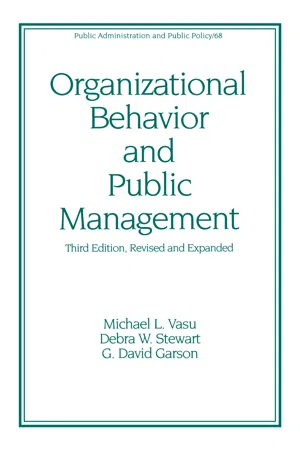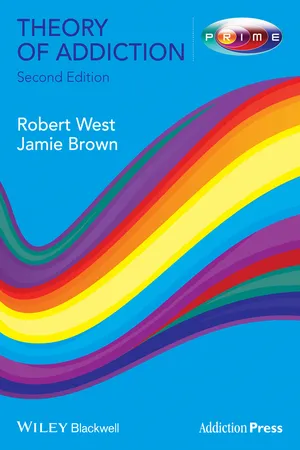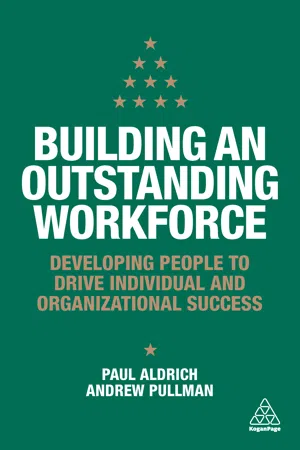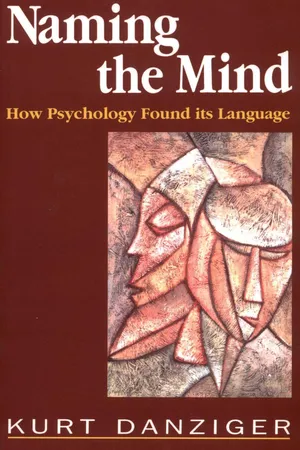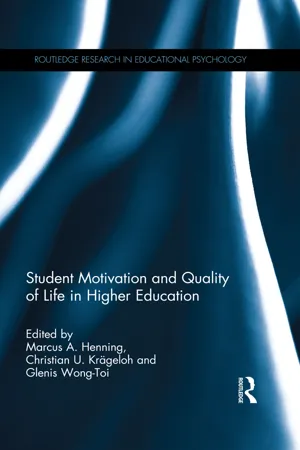Psychology
Theories of Motivation
Theories of motivation in psychology aim to explain why individuals are driven to behave in certain ways. These theories include the instinct theory, drive-reduction theory, arousal theory, and humanistic theory. Instinct theory suggests that behavior is driven by innate biological instincts, while drive-reduction theory posits that motivation arises from the need to satisfy physiological needs. Arousal theory emphasizes the pursuit of an optimal level of arousal, and humanistic theory focuses on the fulfillment of personal potential and self-actualization.
Written by Perlego with AI-assistance
Related key terms
11 Key excerpts on "Theories of Motivation"
- eBook - ePub
Behavioural Research for Marketing
A Practitioner's Handbook
- Julian Adams(Author)
- 2022(Publication Date)
- Routledge(Publisher)
The previous chapters state clearly that understanding human behaviour is a complex and challenging endeavour, with both social influence and personality playing a part in driving behavioural tendencies. If we are to consider why people behave the way they do, we must also look at theories that model motivational forces. We are motivated by fundamental goals of survival and more abstract ones, about creative development and fulfilment. It follows that if we can understand what motivates people, then we can go some way to understanding behaviour.There are many Theories of Motivation, and this field of human observation has remained a key area of interest to psychologists. Theories of Motivation vary significantly in focus, method and, consequently, conclusions. As such, there is little consensus amongst academics; nonetheless, all theories have one thing in common, that is, the notion that human behaviour is in some sense organised and goal-directed.Why are motivational forces important in behavioural research?
Motivational theory provides researchers with frameworks in which to explore motivations in different settings. It follows that if we can understand the factors that sit behind motivation, we can affect behavioural change. In this chapter, we will look at theories that detail the processes of motivation and those that seek to explain the emotions and cognitions that sit behind motivation.In the beginning
Early explanations of motivation centred on instincts; for example, the American philosopher and psychologist William James was influenced by Charles Darwin’s theory of natural selection and suggested a series of instincts, namely, fear, anger, love, shame and cleanliness. Perhaps unsurprisingly, motivation as an instinct is no longer considered valid. In the 1960s, Maslow’s hugely influential hierarchy of needs curried favour.4.1 Hierarchy of needs: determining physiological and higher-order needs
4.1.1 Defining hierarchy of needs
In the mid-20th century, psychologists were exploring the idea that we are motivated by a hierarchy of needs, starting with basic physiological needs extending to higher, more emotional needs. This approach was informed by the humanistic movement, in California, in the 1960s. Humanistic theory contends that both physiological and emotional needs are key motivational drivers. The emergence of the humanistic approach is an example of a paradigm shift, where unease about the emphasis on stimulus reinforcement in behaviourism and irritational thoughts in psychoanalysis, resulted in the advent of a new school of thought. A humanistic approach sits within the subjectivism research philosophy and makes three core existential assumptions: - eBook - ePub
- Nancy Fenton, Jessica Flitter, Jessica Flitter(Authors)
- 2015(Publication Date)
- Research & Education Association(Publisher)
Chapter 10 Motivation and EmotionHuman behaviors are driven by both motivation and emotion. The psychology of motivation is the study of biological and psychological factors that influence the arousal, direction, and persistence of behavior toward a goal. Human motivations can be categorized in terms of physiological or social motives that will be discussed further in this chapter. Emotion is defined by psychologists as a complex internal state generally characterized by a heightened level of physical arousal, cognitive appraisal of the situation, and a subjective feeling. Motivation and emotion are closely connected concepts that influence each other. Psychologists have presented a variety of theories to explain motivation and emotion and how they are impacted by both genetic and environmental factors.Motivation TheoriesWhy do people act the way they do? It is generally agreed that motives energize and provide the purpose behind behavior, but how motivations operate and where they come from are still debatable. There are basic biological motives, including hunger, thirst, sex, and sleep, and learned motives, such as need for achievement and affiliation. Additionally, humans experience emotional motives like pleasure, pain, anger, fear, and frustration. The major psychological theories for the complex processes of human motivations are listed below.Instinct/Evolutionary TheoryThe earliest Theories of Motivation were influenced by the work of Charles Darwin and focused on the identification of human instincts. An instinct is an unchanging sequence of behaviors observed in all members of a species in response to specific stimuli that occurs without learning. Behaviors produced by instinct are not affected by practice. During the early part of the 20th century, hundreds of instinct theorists published long lists of newly identified instincts that were supposed to determine the reasons for the arousal and direction of behavior. The methods utilized by these early instinct theorists have been highly criticized because they did not measure, predict, or explain the existence of instincts. Merely generating long lists of potential instincts does not actually result - eBook - ePub
Psychology in the Classroom
A Teacher's Guide to What Works
- Marc Smith, Jonathan Firth(Authors)
- 2018(Publication Date)
- Routledge(Publisher)
The way in which people attribute the causes of events, therefore, impact on the motivation, due to the belief about the way future events will turn out. Those students who explain their failures in terms of internal and stable factors will view the future in the same way as the present: that nothing they do will make any difference. Success is dismissed as luck and effort rejected. Alternatively, those who view failure in terms of unstable factors (e.g. lack of effort rather than lack of intelligence) are better equipped to view failure and setback as things to be overcome.Humanistic Theories of MotivationWhile attribution theory views motivation as guided by our interpretation of the situation, humanistic psychology emphasises the role of free will and human beings’ capacity for self-development, self-realisation and self-actualisation. It arose as a reaction against the narrow view of the behaviourists and the pessimism of Freudian psychodynamics, with its roots lying more in existential thought and Eastern philosophy than in traditional psychology. Although humanistic psychology has been highly criticised for its lack of scientific rigour, theories based on the humanistic paradigm have remained highly influential.p.217One of the most influential models of motivation that arose out of the humanistic tradition is Abraham Maslow’s hierarchy of needs, first proposed in 1954, but subjected to several revisions and adaptations over the years.Maslow suggested that there are two sets of motivational forces (or needs):1 Deficiency needs (D-needs). Those motivational forces that ensure survival by satisfying basic physical and psychological needs (e.g. safety, love, feelings of belonging).2 Needs related to self-actualisation (B-needs). Behaviours that are engaged for their own sake (i.e. they have no survival advantage) and are intrinsically satisfying.According to the principles of the hierarchy, lower levels require satisfying before higher ones, so only once D-needs are satisfied does it become possible to take on those needs related to self-actualisation (B-needs). Self-actualisation represents the realisation of one’s full potential or, according to Maslow, ‘becoming everything that one is capable of becoming’, especially in the intellectual and creative domains. B-needs represent the fulfilment of ambitions, the acquisition of admired skills, and the steady increase in understanding about people and oneself and the development of creativeness. Essentially, B-needs are concerned with our desire to be good human beings, and are thought to be a later evolutionary adaptation. For our ancestors, survival was the most important life component; there was little time for self-development or the pursuit of self-actualisation. Once our biological needs are satisfied, we can move on to these higher intellectual and self-development needs. Self-actualisation, however, will be different for all of us. In classroom settings, students learn better when their basic needs have been satisfied; hungry and exhausted children make poor learners. - eBook - ePub
Organizational Psychology
A Scientist-Practitioner Approach
- Steve M. Jex, Thomas W. Britt(Authors)
- 2014(Publication Date)
- Wiley(Publisher)
Locke and Latham (2004) have recently illustrated how current Theories of Motivation could be improved. One important recommendation involves integrating the different motivation theories into a comprehensive model of work motivation. Given the diversity of theories discussed in the present chapter, this task is easier said than done. However, it is worth emphasizing that all of the theories proposed likely address a part of what we mean by work motivation, and therefore each theory yields novel recommendations for managers in order to motivate employees to perform well and feel good about their work. Well-articulated and well-supported theories provide managers with considerable informed guidance as they attempt to motivate employees. If no Theories of Motivation were available, managers' attempts to motivate people would essentially be random, or perhaps would be based on each manager's idiosyncratic view of the world. In the next chapter, we examine how these motivation theories are applied in organizations in order to influence a multitude of employee behaviors.Chapter Summary
In this chapter, we reviewed what are considered the major Theories of Motivation in organizational psychology. These theories were organized into five general categories: need-based theories, cognitive process theories, the Behavioral Approach, Self-Determination Theory, and Job-Based Theories. According to need-based theories, motivation is largely rooted in the human desire to satisfy needs. Theories falling under this category included Maslow's Need Hierarchy, Alderfer's ERG Theory, and Achievement Motivation Theory. In general, support for need-based theories has been rather weak, due largely to the difficulty of conceptualizing and measuring needs.Cognitive process theories are aimed at describing the cognitive processes involved in employee motivation. These theories, for example, focus on things such as decision making, levels of aspiration, and self-regulation. Theories discussed under this category included Equity Theory, Expectancy Theory, Goal Setting, and Control Theory. Although all of these theories have been supported, Goal Setting has clearly received the greatest support and has had the most impact within organizations. In the future, as cognitive process theories become more complex, a challenge will be to translate these into a form that can be readily used by managers.The Behavioral Approach to employee motivation involves using principles adapted from behaviorism in order to influence behavior in organizations. The principle used most frequently is reinforcement, although others, such as punishment, shaping, and extinction, may be used in certain situations. Applications of the behavioral approach in organizations, in the form of Organizational Behavior Modification (OBM), have produced impressive results. This approach, however, appears to work best in situations where the jobs being performed are not highly complex. - eBook - ePub
Motivating Humans
Goals, Emotions, and Personal Agency Beliefs
- Martin Eugene Ford(Author)
- 1992(Publication Date)
- SAGE Publications, Inc(Publisher)
Table 6.1 .32 Theories and Categories of Theories of Motivation1. Psychoanalytic Theory. Freud’s theorizing about the powerful internal forces influencing human behavior set the stage for many early theories of human motivation. His emphasis on deep, pervasive drives and instincts—including not only those related to sex and aggression, but also ego- and superego-linked motives associated with competence and morality—helped stimulate early efforts to identify the content of and relationships among major directive influences. Moreover, the enduring influence of his focus on arousal reduction and pleasure seeking as fundamental motivational principles are evident in many historically prominent Theories of Motivation (e.g., drive theory [5], field theory [6], operant learning theory [11]). In addition, his emphasis on the motivational power of particular emotional states (e.g., anxiety and guilt) has provided those attempting to bring emotional processes back into the mainstream of motivational theorizing with a major source of historical strength and inspiration. Thus, although some of the details of Freud’s theorizing appear to be little more than speculative storytelling, the core concepts can be easily identified in updated form even in some contemporary theories focused on the directive and arousal components of motivational patterns.2. Instinct Theory/Hormic Psychology. McDougall’s focus on instincts and the emotion-laden objects associated with those instincts is basically congruent with the emphasis in psychoanalytic theory [1] on the unseen and often unconscious forces within the individual that determine behavior; however, McDougall posited a much longer list of instincts (13 instincts plus a number of “minor” instincts) in an effort to account more specifically for the great variety of activity evident in human behavior patterns. Unfortunately, as noted in Chapter 1 - eBook - ePub
- Graham C. Davey, Graham C. Davey(Authors)
- 2018(Publication Date)
- Wiley(Publisher)
Meeting our basic needs – Most us have been warned not to go food shopping when we are hungry, as we end up buying more than we intended. We could use Maslow’s theory of motivation to explain this finding; when basic needs are unmet, we cannot achieve needs higher up the hierarchy, such as saving.SECTION SUMMARY
- Various Theories of Motivation can be applied to real-life scenarios.
- Motivation plays a big role in how well we perform tasks, and much research has been conducted on the ways in which intrinsic and extrinsic motivation affect performance.
- When we are extrinsically motivated to complete a task, this reduces our intrinsic motivation to complete the task, which is known as the overjustification effect.
- Managers and coaches of sports teams use a variety of motivational techniques.
- Transformational leaders try to boost the motivation and spirits of their team through a combination of idealized influence, individualized consideration, inspiration, and intellectual consideration.
- It is important to develop appropriate self-regulation, particularly when it comes to managing our spending habits.
CHAPTER SUMMARY
This chapter has introduced you to a wide-ranging selection of Theories of Motivation – processes that motivate us to behave in ways that will maximize our survival, enable us to behave purposefully, and pursue goals. The motivation underlying basic physiological processes such as eating, drinking, sex, and aggression were discussed, and then we moved on to more complex forms of motivation behaviour. These include the factors that determine intrinsic and extrinsic motivation, the need to affiliate and to socialize with others, and the need to achieve. We ended the chapter by providing a few simple examples of how these Theories of Motivation have been applied in practice. - Michael L. Vasu, Debra W. Stewart, G. David Garson, Michael L. Vasu, Debra W. Stewart, G. David Garson(Authors)
- 2017(Publication Date)
- Routledge(Publisher)
Behavior needs to be tied to reinforces. These reinforcers may be symbolic, explicit praise, or tangible pay for specific levels of measured performance.Motivation in the Workplace
The preceding review of basic motivation theory provides the conceptual building blocks for models predicting and analyzing motivation on the job. Like the Theories of Motivation put forth above, research on employee motivation falls into two broad categories: (1) research focusing on how changes occurring in the worker yield changes in behavior (rooted in cognitive theory): and (2) research asking how reinforcement of behavior itself yields changed behavior (rooted in acognitive theory). Each of the approaches in the cognitive tradition gives rise to distinctive prescriptive models for motivating employees.Applications Deriving from the Cognitive Tradition
Theory X, Theory Y, Theory Z
The first model stemming from the human growth development approach is the previously mentioned Theory X, Theory Y analysis of motivation by Douglas McGregor. Douglas McGregor, in his classic work, The Human Side of Enterprise (1957), builds a theory of work motivation premised on the humanistic psychology of Abraham Maslow.There are at least five sets of goals which we may call basic needs. These basic goals are related to each other, being arranged in a hierarchy of prepotency. When a need is fairly well satisfied, the next prepotent (“higher”) need emerges, in turn to dominate the conscious life and to serve as the center of organization of behavior, since gratified needs are not active motivators (Maslow, 1943).Accepting this analysis of human nature with needs arranged from physiological, to safety, to social, to ego, to self-actualization in ascending order of potency, McGregor criticizes conventional managerial theory for making incorrect assumptions about the management process. According to McGregor, conventional management theory, or Theory X, believes that without active intervention by management, people would be passive, even resistant, to organizational needs. Theory X sees the average person as indolent by nature, lacking ambition, disliking responsibility, and preferring to be led. The typical employee is inherently self-centered, indifferent to organizational needs and by nature resistant to change (McGregor, 1957). In effect, they are at best motivated by the lower levels of the needs hierarchy. McGregor argues that the Theory X philosophy confuses cause and effect in its analysis of human nature. If the employee in the modern organization is the passive indifferent actor described above, it is in response to existing management philosophy, policy, and practice. He is “sick” because of deprivation of a higher level need. This sickness has the behavioral consequences outlined above. While the contemporary organization meets the physiological and safety needs of most employees, social needs are viewed by management as a threat to the organization so the organization seeks to inhibit them.- eBook - ePub
- Robert West, Jamie Brown(Authors)
- 2013(Publication Date)
- Wiley-Blackwell(Publisher)
Understanding addiction requires an understanding of the human motivational system. This is the system of brain processes that energise and direct our actions; it shapes the flow of behaviour on a moment-to-moment basis. There are many Theories of Motivation (for an excellent overview, see Mook 1996). Surprisingly none has sought to integrate all of its major modes of operation from conscious decision-making through to classical and instrumental learning processes. Therefore, it is necessary to develop a synthetic theory of motivation as the basis for a theory of addiction.A synthetic theory of motivation
The theory specifies the key elements of the ‘motivational system’ (structure), how they react to input, and interact with each other to generate behaviour (function), and how their properties change over time through maturation, internal interactions and external influences (ontogenesis). It recognises that the motivational system is a product of evolution and that we share many processes with other species. It describes how the uniquely human and more generic animal parts of the system interact.When it comes to the structure of the human motivational system, the theory identifies five major interacting subsystems of which any can function abnormally in addiction. The system as a whole is captured by the acronym PRIME, which stands for plans, responses, impulses, motives and evaluations.Figure 8.2 shows the five subsystems of the motivational system. Plans are self-conscious intentions; responses involves starting, stopping or modifying actions; impulses and inhibitions are the final common pathway to behaviour; motives are feelings of want or need and evaluations are beliefs about what is good or bad.Figure 8.2 A schematic of the five subsystems that make up the human motivational system.Opportunities for influence between the subsystems involved in generating these mental activities are shown by their being adjacent to each other in the schematic. For example, motives can only exert influence on responding through impulses, and evaluations can only influence responses through motives and then impulses. Plans provide a structure to our actions and influence them primarily through evaluations operating at the time when they are to be executed. - eBook - ePub
Building an Outstanding Workforce
Developing People to Drive Individual and Organizational Success
- Paul Aldrich, Andrew Pullman(Authors)
- 2019(Publication Date)
- Kogan Page(Publisher)
Many of the factors that may influence motivation make intuitive sense, for instance: positively reinforcing performance, creating supportive environments, setting clear and attainable work goals, providing appropriate resources, and making sure there is a fit between employee and employer values and motives. However, motivation is also dependent on individual aspects such as:ability – job knowledge, skills, disposition – stable traits, beliefs and values, affective mood state; and job context, for instance ‘nature of the task/job, physical environment, implicit and explicit rewards – reinforcers, wider corporate culture and social norms.2There have been attempts to group Theories of Motivation and then assess their predictive ability around satisfaction, productivity and turnover, for instance theories around content – why people work, and theories around process - eBook - ePub
Naming the Mind
How Psychology Found Its Language
- Kurt Danziger(Author)
- 1997(Publication Date)
- SAGE Publications Ltd(Publisher)
The energy vs. direction distinction provided the basis for interpreting all behaviour in instrumentalist terms (Koch, 1956). Only a few actions, such as eating and copulating, were classified as ‘consummatory’. For the rest, ‘consummation’ was extrinsic to the action itself, though the ‘need’ for such consummation was supposed to supply the energy without which no action would take place. For the discipline of Psychology, the advantage of this model was that it made possible the integration of practical and scientific imperatives. The burgeoning practical interest in ‘motivation’ as a means of social control, discussed in the previous section, had presupposed instrumentalism. One could influence people’s actions as producers and consumers by playing on the motives they had for working or for purchasing products. These motives were thought of as extrinsic to the actions themselves. One could induce individuals to work more intensively or more consistently by exciting personal ambitions; one could induce them to purchase one’s brand of drugs or cosmetics by exciting fear and envy. Implicitly, there was a notable lack of faith in the intrinsic attractions of work, of many consumer products, and more generally, of socially valuable activity. What a science of ‘motivation’ might supply were principles to guide attempts at influencing people’s actions by controlling the extrinsic motives that governed those actions.Such hopes jibed comfortably with the prevailing engineering model of science. The principles to be looked for took the form of linear sequences of efficient causality. In the paradigmatic experimental situation, starving the rat was conceived as being analogous to pulling a control lever on a piece of machinery that would set in motion a chain of causes and effects. Conceptually, this was represented, both by Tolman and by Hull, in terms of a series of links between antecedent, intervening and consequent variables.5An important feature of the neo-behaviourist use of the drive concept was its stipulative - Marcus Henning, Christian Krägeloh, Glenis Wong-Toi(Authors)
- 2014(Publication Date)
- Routledge(Publisher)
Part II Theoretical perspectivesThis section introduces the terms motivation to learn and quality of life with the view to creating a link with higher education. It also includes a chapter that explains and applies the notion and practice of positive psychology and how this aspect of psychology can inform educational practice. These chapters were compiled from reviews of the relevant literature intermeshed with professional experience. They were written as introductory chapters, with the intention of providing a sound information base to inform later readings within the book.Passage contains an image
3 Motivation to learn
Marcus A. Henning1 and Emmanuel Manalo21 University of Auckland, New Zealand2 Waseda University, JapanDOI: 10.4324/9781315814070-4Key ideas- Most Theories of Motivation share the same or similar constructs and processes in elucidating the inextricable links between motivation and learning.
- The expectancy-value theory and the achievement goal theory are two Theories of Motivation that are most pertinent to higher education contexts.
- An integrative model (presented at the end of the chapter) shows the key factors that affect academic motivation; it aims to create a better understanding of the relationships between these factors and how they affect learning outcomes.
This chapter reviews a selection of motivation theories that are particularly relevant to research and practice in the area of higher education. The two theories most useful towards understanding and addressing learning issues in higher education are the expectancy-value theory and the achievement goal theory. Numerous other theories, however, also contribute significantly to achieving a basic understanding of the connections between motivation and learning; thus, key aspects of some of those other theories will also be described briefly.
Index pages curate the most relevant extracts from our library of academic textbooks. They’ve been created using an in-house natural language model (NLM), each adding context and meaning to key research topics.



